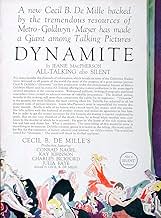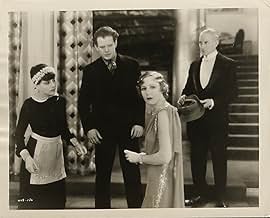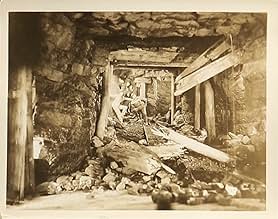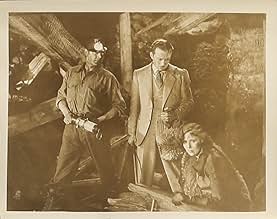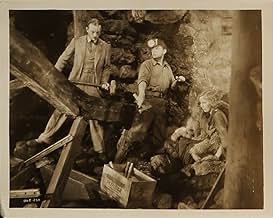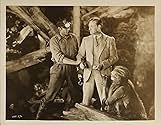Aggiungi una trama nella tua linguaWealthy Cynthia is in love with not-so-wealthy Roger, who is married to Marcia. The threesome is terribly modern about the situation, and Marcia will gladly divorce Roger if Cynthia agrees t... Leggi tuttoWealthy Cynthia is in love with not-so-wealthy Roger, who is married to Marcia. The threesome is terribly modern about the situation, and Marcia will gladly divorce Roger if Cynthia agrees to a financial settlement. But Cynthia's wealth is in jeopardy because her trust fund will ... Leggi tuttoWealthy Cynthia is in love with not-so-wealthy Roger, who is married to Marcia. The threesome is terribly modern about the situation, and Marcia will gladly divorce Roger if Cynthia agrees to a financial settlement. But Cynthia's wealth is in jeopardy because her trust fund will expire if she is not married by a certain date. To satisfy that condition, Cynthia arrange... Leggi tutto
- Regia
- Sceneggiatura
- Star
- Candidato a 1 Oscar
- 1 vittoria e 1 candidatura in totale
- Bobby
- (as Douglas Frazer Scott)
- Good Mixer
- (non citato nei titoli originali)
- Mine Foreman
- (non citato nei titoli originali)
Recensioni in evidenza
The in-between-the-lines context of this movie is also remarkable. Recall that Prohibition of alcoholic beverages had been in effect as a federal mandate for nearly ten years, and that many States had been "dry" with Prohibition for longer than that. But "the glittering society" depicted in this movie was positively soaking in booze. Clearly this movie was written and filmed well before the banking crisis of 1928-29 turned into the bank failures and bank runs of the early 1930s. The pace of the language, the styles, the ways of talking and relating expressed in "Dynamite" show the viewer -- now seventy-five years later -- that the Roaring '20s were very frenetic, indeed.
Prohibition was something for the small towns and rural areas, or so it was said, then. It came into being because activist female leaders made their case that drunken behavior and alcoholism were twin punishments on women and on their children. The majority of bad and abusive drunks in that era, 1880 to 1920, were men, of course. The ones who suffered from their abusive behaviors were their women and their children, or others in their families.
This is a movie which is all about women and men. The lead character, Buddy Derks, is about to be executed for a murder he didn't commit. In a drunken carouse, the young man who committed the murder assaults his drinking buddy with a knife, and this fellow in his turn shoots his friend, fatally wounding him. Before he dies, on the floor of the swank club where they're drinking, he confesses to the murder which Derks has been saddled with. Justice is swift, surprisingly so, and Derks is suddenly released from death row.
He goes then to confront the society 'dame' who paid him $10,000 to marry her, in a jail cell ceremony. The why and wherefore of this marriage of convenience are really extraordinary and that twist makes the movie worth seeing, alone. But suddenly the "dame" has a husband that she really does not want, and that's where the fun begins ....
Bickford is amazing in this movie. He clearly overacts, but it seems somehow so natural for him to do so. Everybody in this moving is either dancing or roaring, it seems, so now we know something about how the Roaring '20s roared !
This "Dynamite" is pure dynamite. TCM has done film buffs a great service by showing it all, and there's every reason to petition them to show it again and again, and not just in the middle of the blooming night !! This movie earned an * 8 * for my vote and I would have given it higher marks if the sound track was made more clear, all the way through. As it stands, it is a unique and appealing cinematic treat.
I recommend it most highly and without mental reservations.
*** (out of 4)
Cecil B. DeMille's first talkie was the first of three pictures that the legendary director would make at MGM. The filthy rich Cynthia (Kay Johnson) needs to be married on her birthday or else she'll lose millions from her grandfather's will. The only problem is that her boyfriend (Conrad Nagel) is already married to a woman who doesn't mind her husband dating Cynthia but she refuses to marry him unless the money is right. On the other side of the tracks, convicted killer Hagon (Charles Bickford) is about to be put to death and offers his body for $10,000 so that his kid sister will be taken care of. Cynthia decides to marry the death row inmate so that she can be "married" on her birthday and since she'll be a widow soon after she can get back to her normal life. The only problem is that after the marriage the real killer comes forward and Hagon is set free.
Is that enough plot for you? DYNAMITE features enough plots for about ten different movies and everything I wrote above is just the opening forty-minutes and that leaves eighty-seven more minutes of craziness. This is without question an incredibly bizarre film but there's no question that it's highly entertaining on so many levels. One such level is that it's just downright nuts from start to finish and I just sat there watching it in a complete amazement that anyone could actually pull it off. DeMille proves what a genius he was by taking this outrageous stories and making them work. If any other director had tried this we'd laugh them right out of the theater. I'm not sure what DeMille's secrets were but he makes us care about the characters and their fate. It also doesn't hurt that we're given some excellent performances with Bickford leading the way as the tough coal miner. This is the type of role he could play in his sleep and he pulls it off wonderfully. Johnson is very believable and good in her part as is Nagel. Julia Faye plays his wife and we get supporting performances from Joel McCrea and William Holden.
DYNAMITE features some very campy moments including the scene where the killer confesses to the crime. I dare you not to laugh during this sequence. I also found it rather hilarious how casual the wife, her husband and the lover were at hanging out with each other. I think this threesome relationship is something that even Jerry Springer would roll his eyes at. Still, this is so entertaining that it really doesn't matter and it would make a great double feature with DeMille's other 1929 film, THE GODLESS GIRL.
Ordinarily I'm not that huge a fan of DeMille, but I found his first foray into sound, "Dynamite", a very good and innovative film. The actors don't speechify endlessly, the camera moves, and the story moves with it. Unlike many films from 1929 it's worth a repeat viewing for the entertainment value, not just the novelty of seeing an industry in transition.
That doesn't mean that there isn't plenty of an industry in transition on exhibit, but rather than inane musical numbers, De Mille uses sound appropriately and also employs largely unknown actors from the stage to keep the emphasis on the plot and in particular, the relationships. From the hammering of the builders of Hagan Dirk's gallows and the singing of "How Am I to Know" by a fellow death row prisoner played by Russ Columbo during the wedding scene, to the strange aero wheel race at the country club, to the playing of a particular song on the radio introducing a romantic moment, this film was an innovative technological marvel when it was first released. However, technological marvels fade with time, and what you do remember are relationships that hit home and are memorable. Many have already stated the outrageous premise of the plot. What is not outrageous and rings true after almost 85 years is how you don't get to pick who you love - it just happens and it can often be most inconvenient, and how heroes can be found in the strangest places and in people you would not think would be up to the task.
I'd recommend this one highly and not just to early talkie enthusiasts.
DeMille's first sound talking movie under Metro-Goldwyn-Mayer was December 1929's "Dynamite." The director looked towards perfection in his selection of articulate talented actors. Mitchell Leisen, DeMille's assistant as well as his set designer for this movie, screen tested dozens of potential candidates. The list was a who's who in future stars: Dean Jagger, Randolph Scott, Carole Lombard. Two of the three top roles were filled by stage actors appearing in their first movie. The other was a veteran of silent movies.
Actress Kay Johnson earned the lead as socialite Cynthia Crothers, a woman who is passionately in love with married Roger Towne (Conrad Nagel). Cynthia is about to inherit a large inheritance from her late rich grandfather, but has to marry within a month to get it. Since Roger's pending divorce won't come in time, accused murderer Hagon Derk (Charles Bickford), on death row, wants to donate his body to whomever is willing to pay him $10,000 to help his poor sister. Cynthia, seeing his ad, goes to propose a marriage for the money. He accepts. They get married. Minutes before his execution, the real murderer confesses, freeing Derk. That's when things get really interesting for the coal miner Derk, Cynthia and Roger.
DeMille was ready to make movies with the microphone. As his publicist stated, "Cecil DeMille will rehearse the cast of Dynamite until it is letter perfect. This is the first time he has directed dialogue rehearsals since he left Broadway sixteen years ago." The director himself publicly stated he wasn't intimated by the new process: "Dynamite" was my first contribution of any value to sound pictures, retaining the silent techniques, and combining those techniques with sound. I brought those two together, and that perhaps is what 'Dynamite' did for the world." The movie was helped by the strong performances of the three main actors. Kay Johnson attended the American Academy of Dramatic Arts in New York City and appeared in several Broadway plays before getting the call-up from DeMille to appear as Cynthia. During the production, she came down with appendicitis and had to be operated on. Her movie career slowed down in the late 1930s after a robust series of film roles until she and her actor/director husband, John Cromwell, adopted a child and had one of their own, James. Fans of the TV show 'All in the Family' will recognize her son James as Archie's friend Stretch Cunningham. When Johnson divorced John in 1946, she remained in Waterford, CT., where she died at 71.
Charles Bickford, as Hagan Derk, was also a stage actor, playing alongside James Cagney in his first Broadway role in 1925's 'Outside Looking In.' His forceful film presence resembles his real personality as a strong outspoken character. At nine he was charged with attempted murder for shooting a trolly driver after his bus ran over his dog. When filming 'Dynamite," Bickford got in a physical fist fight with one of the assistant directors over his portrayal of Derk, and was always at odds with MGM studio head Louis Mayer. As a freelancer in the mid-1930s, he was mauled by a lion filming 1935's "East of Java," resulting in extensive neck scars. He never quite achieved top-tier star status, but became a popular character actor, earning three Academy Award nominations.
Busy actor Conrad Nagel was already in his 11th talkie. He was one of the few silent film stars to easily make the transition to the movie sound stage, working into the late 1950's after his film debut in 1918.
"Dynamite" was the first DeMille picture to earn an Academy Awards nomination. Leisen, the man who screen tested all the main actors in "Dynamite," was nominated for Best Art Direction.
Lo sapevi?
- QuizCarole Lombard was replaced during filming, but can still be seen in the released print.
- Citazioni
Hagon Derk: Ahhhh... bull!
- Curiosità sui creditiFilm Title is shown as the word DYNAMITE written on a box of..... dynamite, after being set down by a worker.
- Versioni alternativeMGM also released this as a silent movie.
- ConnessioniEdited into Histoire(s) du cinéma: Fatale beauté (1994)
- Colonne sonoreHow Am I to Know
(1929) (uncredited)
Music by Jack King
Lyrics by Dorothy Parker
Played on guitar and sung by Russ Columbo in prison
Played on radio and hummed and sung by Kay Johnson
Played on piano as background music and played at the end
I più visti
Dettagli
- Tempo di esecuzione2 ore 9 minuti
- Colore

